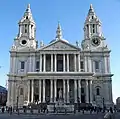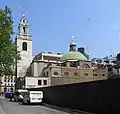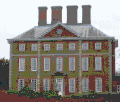Christopher Wren
Sir Christopher Wren (20 October 1632 – 25 February 1723) was a 17th century English architect, designer, astronomer and geometer. He designed 51 churches in London after the Great Fire of London, including St. Paul's Cathedral.[1][2]
Sir Christopher Wren | |
|---|---|
 Wren in a portrait by Godfrey Kneller (1711) | |
| Born | 30 October 1632 [O.S. 20 October] East Knoyle, Wiltshire, England |
| Died | 8 March 1723 [O.S. 25 February, 1722] (aged 90) St James's, London, England |
| Nationality | English (later British) |
| Alma mater | Wadham College, Oxford |
| Known for | Designer of 54 churches including St Paul's Cathedral, as well as many secular buildings of note in London after the Great Fire |
| Scientific career | |
| Fields | Architecture, physics, astronomy and mathematics |
| Academic advisors | William Oughtred |
Wren was born on 20 October 1632 in East Knoyle, Wiltshire, England. He was educated at Westminster School and Oxford University. He showed an early talent for mathematics. He invented an instrument for writing in the dark and a pneumatic machine. In 1657, Wren was appointed professor of astronomy at Gresham College in London. Four years later, he was appointed professor of astronomy at Oxford. In 1662, he was one of the founding members of the Royal Society.
Wren developed an interest in architecture following his studies of physics and engineering. In 1664 and 1665, Wren designed the Sheldonian Theatre in Oxford and a chapel for Pembroke College, Cambridge. Thereafter, architecture became his main focus. In 1665, Wren visited Paris. He studied French and Italian baroque styles.
In 1666, the Great Fire of London destroyed much of the medieval city. Wren produced ambitious plans for rebuilding the whole area. His plans were rejected, partly because property owners insisted on keeping the sites of their destroyed buildings. Wren did design 51 new city churches, including a new St Paul's Cathedral. In 1669, he was appointed surveyor of the royal works. This gave him control of all government building in the country. He was knighted in 1673.
In 1675, Wren was commissioned to design the Royal Observatory at Greenwich. In 1682, he designed a hospital in Chelsea, London for retired soldiers, and in 1696 a hospital for sailors in Greenwich. Other buildings include Trinity College Library in Cambridge (1677 - 1692), and the facade of Hampton Court Palace (1689 - 1694). Wren often worked with the same team of craftsmen, including master plasterer John Groves and wood carver Grinling Gibbons.
Wren died on 25 February 1723. He was buried in St. Paul's Cathedral. His gravestone features a Latin inscription which translates as: 'If you seek his memorial, look about you.'[3]
Gallery of architectural work
 Sheldonian Theatre, Oxford University
Sheldonian Theatre, Oxford University Interior, Sheldonian Theatre, Oxford University
Interior, Sheldonian Theatre, Oxford University Tom Tower, Christ Church, Oxford University
Tom Tower, Christ Church, Oxford University St. Paul's Cathedral, west front
St. Paul's Cathedral, west front St. Paul's Cathedral, north side with the Chapter House (also by Wren)
St. Paul's Cathedral, north side with the Chapter House (also by Wren) St. Paul's Cathedral, south transept & dome
St. Paul's Cathedral, south transept & dome The Lantern, St. Paul's Cathedral
The Lantern, St. Paul's Cathedral Top of north-west tower, St. Paul's Cathedral
Top of north-west tower, St. Paul's Cathedral The nave of St. Paul's Cathedral
The nave of St. Paul's Cathedral St. Paul's Cathedral, interior of the dome
St. Paul's Cathedral, interior of the dome Temple Bar London
Temple Bar London Library, Trinity College, Cambridge University
Library, Trinity College, Cambridge University Library, Trinity College, Cambridge University, from the river
Library, Trinity College, Cambridge University, from the river Library interior, Trinity College, Cambridge University
Library interior, Trinity College, Cambridge University Marlborough House, Westminster as designed by Wren
Marlborough House, Westminster as designed by Wren Marlborough House, Westminster as altered
Marlborough House, Westminster as altered Hampton Court Palace, south front
Hampton Court Palace, south front Hampton Court Palace, east front
Hampton Court Palace, east front Kensington Palace, south front
Kensington Palace, south front Royal Hospital Chelsea, south front
Royal Hospital Chelsea, south front Royal Hospital Chelsea, The Chapel
Royal Hospital Chelsea, The Chapel Royal Hospital Chelsea, Dining Hall
Royal Hospital Chelsea, Dining Hall Greenwich Hospital, north front
Greenwich Hospital, north front Greenwich Hospital, Painted Hall
Greenwich Hospital, Painted Hall Greenwich Hospital, the Dome, Painted Hall
Greenwich Hospital, the Dome, Painted Hall St. Bride's Fleet Street, spire
St. Bride's Fleet Street, spire St. Mary-le-Bow, steeple
St. Mary-le-Bow, steeple St. Mary-le-Bow, interior
St. Mary-le-Bow, interior St Benet's Paul's Wharf
St Benet's Paul's Wharf St. Margaret Pattens
St. Margaret Pattens St. Lawrence Jewry
St. Lawrence Jewry St. Mary Abchurch, interior of dome
St. Mary Abchurch, interior of dome St. Mary Abchurch
St. Mary Abchurch St. Peter Upon Cornhill
St. Peter Upon Cornhill St. Stephen's Walbrook, exterior
St. Stephen's Walbrook, exterior St. Stephen's Walbrook, interior
St. Stephen's Walbrook, interior Christchurch, Newgate St
Christchurch, Newgate St St. Magnus-the-Martyr, steeple
St. Magnus-the-Martyr, steeple St. Magnus-the-Martyr, interior
St. Magnus-the-Martyr, interior St. Vedast Foster Lane
St. Vedast Foster Lane St. James Piccadilly
St. James Piccadilly St. James Piccadilly, interior
St. James Piccadilly, interior St. Clement Danes
St. Clement Danes St. Clement Danes, interior
St. Clement Danes, interior St. Martin within Ludgate
St. Martin within Ludgate The Monument to the great fire of London
The Monument to the great fire of London Emmanuel College, Cambridge University, the Chapel
Emmanuel College, Cambridge University, the Chapel The Royal Observatory, Greenwich
The Royal Observatory, Greenwich Theatre Royal Drury Lane, demolished
Theatre Royal Drury Lane, demolished Library, Lincoln Cathedral
Library, Lincoln Cathedral Winslow Hall, Buckinghamshire
Winslow Hall, Buckinghamshire The chapel, Pembroke College, Cambridge University
The chapel, Pembroke College, Cambridge University The interior looking west, The chapel, Pembroke College, Cambridge University
The interior looking west, The chapel, Pembroke College, Cambridge University Windsor Guidhall
Windsor Guidhall
References
- Tinniswood, Adrian 2001. His Invention so furtile: the Life of Christopher Wren. Oxford University Press. ISBN 0-19-514989-0
- Vaughan Hart. 1995. St Paul's Cathedral: Sir Christopher Wren. Phaidon, London. ISBN 0714829986
- BBC: Christopher Wren